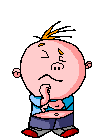Ms. Spenser's Studies
Uh Oh, I Didn't Know!
Beginning Reading Design by Spenser Phillips
Rationale:
This lesson teaches children about the short vowel correspondence u =/u/. In order to be able to read, children must learn to recognize the spellings that map word pronunciations. In this lesson children will learn to recognize, spell, and read words containing the spelling u. They will learn a meaningful representation (Uhh, I don’t know!), they will spell and read words containing this spelling in a letterbox lesson, and read a decodable book that focuses on the correspondence u=/u/.
Materials:
Graphic image of confused boy; cover-up critter; whiteboard or smartboard Elkonin boxes for modeling and individual Elkonin letterboxes for each student; letter manipulatives for each child and magnetic or smartboard letters for teacher: u, p, t, b, j, g, l, o, n, c, k, s, m, p, r; list of spelling words on poster or whiteboard to read: 2- [up] 3- [tub, jug] 4- [long, luck, scum, plop, junk, crush] 5- [crust, flunk] psuedoword- [zust]; decodable text Fuzz and the Buzz; and assessment worksheet.
Procedures:
-
Say: In order to become expert readers, we need to learn the code that tells us how to pronounce words. Today we are going to learn the short vowel sound /u/. When I say /u/ I think of the sound I make when I’m confused “uhh” and scratch my head [show graphic image]. Can you say uhh and scratch your head like you’re confused?
-
Say: Before we learn about the spelling of /u/, we need to listen for it in some words. When I say /u/, I notice my mouth is open and my tongue is pressing down (make vocal gesture for /u/). I will show you first: gum. I hear /u/ and I felt my mouth open and my tongue press downward making the /u/ sound. There is a short U in gum. Now I’m going to see if it is in the word fog. Hmm, I didn’t hear the /u/ sound and my mouth did not open while my tongue was pressing down. Now it’s your turn to try! If you hear the /u/ sound say, uhh, what. If you don’t hear it, I want you to say, no! Do you hear /u/ in run, stop, punk, fluff, slot, plus, clock, lunch, dinner?
-
What if I want to spell the word flunk? “I have to study or I’ll flunk my test!” Flunk means to do badly in this sentence. To spell flunk in letterboxes, first I need to know how many phonemes I have in the word so I stretch it out and count: /f//l//u//n//k/. I need 5 boxes. I heard that /u/ just before the /n/ so I’m going to put u /in the fourth box and the k in the fifth box. The word starts with /f/, that’s easy; I need an f. Now it gets a little tricky so I’m going to say it slowly, /f//l//u//n//k/. I think I heard /l/ so I’ll put the l right after the f. I can spell flunk!
-
Now I’ll show you how I would read a tough word. [Display poster with on the top and model reading the word.] I’m going to start with the ; that part says /u/. Now I’m going to put the beginning letters with it: s-h-r-u, /shru/. Now I’ll put that chunk together with the last sound, /shru-nk/. Oh, , like “My mom shrunk my shirt.” I can read shrunk
-
Say: Now I’m going to have you spell some words with letterboxes. You’ll start out easy with two boxes for up. “I looked up to the sky.” Did you remember that /u/? I’ll check your spelling while I walk around the room. [Observe progress.] You’ll need three letterboxes for the next word. Listen for the beginning sound to spell in the first box. Then listen for /u/. Here’s the word: tub, “I took a bath in the tub.” [Allow children to spell remaining words, giving sentences for each word: jug, long, luck, scum, plop, junk, crust.
-
Say: Now I am going to let you read the words you’ve spelled. [Show the words up, tub, jug, long, luck, scum, plop, junk, crust, the extra words crush and flunk, and the pseudoword zust. Have children read words in unison. Afterwards, call on individuals to read one word on the list until everyone has had a turn.
-
Say: You’ve done an awesome job at reading words with our new spelling for u=/u/. Now we are going to read a book called Fuzz and the Buzz. This story is about Fuzz! One day Fuzz runs in the hot sun. He tugs at some nuts. The nuts fall down and bop his head! Fuzz gets mad and yells! The mad bugs buzz and buzz at Fuzz. Oh no! Are the bugs going to get fuzz? Let’s pair up and take turns reading Fuzz and the Buzz to find out what happens to Buzz. [Children pair up and take turns reading alternate pages each while the teacher walks around the room monitoring progress. After individual paired reading, the class rereads Fuzz and the Buzz chorally, stopping between page turns to discuss the story.
-
Say: Before we finish up with our lesson about u=/u/, I want to complete this worksheet. Draw a line thte pictures that start with u. When you've finished, color the pictures. [Collect worksheets to evaluate individual child progress.]
References:
Phonics Readers. Fuzz and the Buzz. Educational Insights, 1990.
Murray, G. Oh, I didn’t know! Reading Genie: https://sites.google.com/site/readingwritingconnection/beggingreadingdesign
Nelson, S. Say “Uh” With Caveman Dug! Reading Genie: https://sites.google.com/site/sarahnelsonedmd3300/lesson-designs/beginning-reading-design
Assessment worksheet: http://www.kidzone.ws/kindergarten/vowels/u-begins1.htm
Click here to return to the Handoffs Index.
